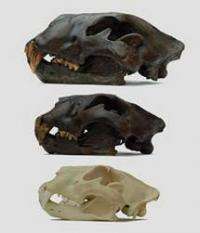Scientists reveal family tree of 'super-sized lions'

(PhysOrg.com) -- The giant cats that roamed the British Isles, as well as Europe and North America, as recently as 13,000 years ago were lions rather than giant jaguars or tigers, a team led by Oxford University scientists has proved.
In order to determine the family tree of these cats, which lived in Britain during the Pleistocene (1.8 million years ago - 10,000 years ago), the team analysed DNA from fossils and other remains gathered from Germany to Siberia in Europe and Alaska to as far south as Wyoming in the USA. A report of the research is published in this week’s Molecular Ecology.
‘These ancient lions were like a super-sized version of today’s lions, up to 25 per cent bigger than those we know today and, in the Americas, with longer legs adapted for endurance running,’ said Dr Ross Barnett who conducted the work at Oxford University’s Department of Zoology. ‘What our genetic evidence shows is that these ancient extinct lions and the lions of today were very closely related. Meanwhile, cave art suggests that they formed prides, although the males appear not to have had manes.’
The team found that these Pleistocene lions could be divided into two genetically distinct sub-groups; lions that inhabited northern Eurasia as well as Alaska and the Yukon, and lions from the southern half of North America.
'This unusual distribution is explained by Ice Age geography when a land bridge linked Siberia and Alaska, enabling ancient lions to cross from Eurasia into North America. At some point the North American ice sheets would have interrupted this migration route - creating these two genetically distinct groups of animals,’ said Dr Barnett.
The British and European lions and their American counterparts lived in a very different world from the African savannah we associate with these big cats today: during the Pleistocene the UK landscape was more like the icy tundra of the modern Russian Steppe and was home to herds of large animals such as mammoth, woolly rhino and giant deer. 13,000 years ago the lions, along with all these giant herbivores, died out in a mass extinction.
‘We still don’t know what caused this mass extinction, although it is likely that early humans were involved in one way or another,’ said co-author Dr Nobby Yamaguchi of Oxford University’s Wildlife Research Conservation Unit (the WildCRU). ‘But what our research does help with is building up a picture of how these large animals were faring before the extinction took place. In the case of these lions our analysis of mitochondrial DNA shows that 30-40,000 years before they became extinct they had lost a substantial part of their genetic diversity. This might be because of local extinctions and recolonisations of some areas, or because some lion groups had an advantage over others and replaced them - as yet we can’t be sure.’
Provided by Oxford University (news : web)















